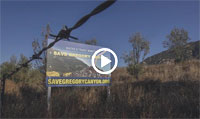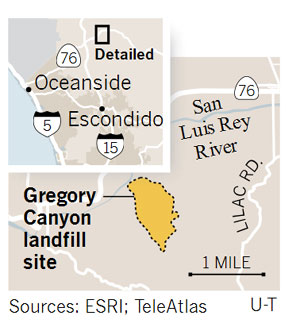Gregory Canyon Landfill project dead as Pala tribe buys part
of land
By J. Harry Jones | November 17, 2016
A
controversial plan to build a landfill in rural northern San
Diego County has been scrapped, and a key piece of the land
has been sold to a Native American tribe that opposed the
project.
 The
deal announced Thursday puts an end to a 25-year fight over
the proposed Gregory Canyon landfill that included several
lawsuits and two countywide ballot measures. The city of Oceanside,
environmental groups and the Pala Band of Mission Indians
had all tried to block the project, but it steamed ahead until
a few years ago when financing problems forced the property
owner into bankruptcy. The
deal announced Thursday puts an end to a 25-year fight over
the proposed Gregory Canyon landfill that included several
lawsuits and two countywide ballot measures. The city of Oceanside,
environmental groups and the Pala Band of Mission Indians
had all tried to block the project, but it steamed ahead until
a few years ago when financing problems forced the property
owner into bankruptcy.
A
new owner, GCL LLC, stepped in last year and there were signs
the dump might finally get off the ground. Instead, the company
said Thursday it had sold roughly 700 acres of the 1,700 acre
site to the Pala tribe for $13 million, effectively killing
the landfill plan.
The
agreement includes a pledge that the tribe won’t oppose
residential and commercial development on the rest of the
property, said Todd Mikles, a principal of GCL.
Pala
officials confirmed that promise. They said the land purchase
ensures the protection of several sites that are sacred to
the tribe and steeped in cultural significance.
“The
deal includes all of Gregory Mountain — we already owned the
eastern side — and all of Gregory Canyon, so that makes it
impossible for there to be any sort of landfill development
there,” said Shasta Gaughen, the tribe’s environmental director
and historic preservation officer. “This outcome, with the
tribe owning one of the most sacred sites we have — I didn't’
see it ending like this and I couldn’t be happier.”
 She
said the tribe began meeting with GCL in September and that
the deed to the 700 acres was recorded at 8 a.m.Thursday. She
said the tribe began meeting with GCL in September and that
the deed to the 700 acres was recorded at 8 a.m.Thursday.
Landfill
opponents like environmental attorney Everett DeLano said
they were thrilled by the news.
“I’ve
been fighting this thing for so many years,” he said.
“It’s amazing it’s finally over. It’s
wonderful. Good job Pala.”
The
proposed dump had been controversial since initial plans were
unveiled in the early 1990s, calling for the project to be
built on a sprawling piece of land that straddles state Route
76 roughly three miles east of Interstate 15, not far from
the San Luis Rey River. The Pala reservation lies just to
the east.
Protecting
the river and the underground water supply became the focus
of several environmental groups and municipalities that banded
together to fight the project. The tribe’s objections
to the dump, however, were both pragmatic and spiritual.
Sharing
a road with roughly 500 trash trucks a day would have been
bad for Pala residents and casino visitors, they acknowledged.
But far worse was building a landfill next to Gregory Mountain.
They said the prospect was akin to building a trash dump around
the walls of a cathedral.
Gregory
Mountain is known as Chokla to native people and it is where
Takwic, a balancing spirit who can appear in human form or
as a ball of fire, sometimes rests, Gaughen said.
“Native
ways of knowing and navigating the spiritual and sacred often
leave no trace on the land,” she said. “Yet the
mark they leave on the cultural lives of the people is indelible.”
The
tribe poured millions into fighting the dump proposal.
Still
in 1994 county voters approved Proposition C, a measure that
amended the county’s general plan and zoning ordinance
to allow a landfill without a major-use permit, thereby —
at least theoretically — streamlining the project’s
approval. Ten years later, the project withstood another major
challenge when voters rejected a ballot initiative, funded
primarily by the tribe, that would have invalidated Proposition
C.
Although
the developers won some major permits, several other key ones
remained including one from the U.S. Army Corps of Engineers,
which had a say because of the dump’s proximity to the
San Luis Rey River.
Work
on the permits ground to a halt in 2014 when the landfill
developer struggled to find financing and fell into bankruptcy.
Last year, a new company — Sovereign Capital — assumed
control of the company, paying off its $200 million debt and
buying the 1,770-acre property for $18 million at a foreclosure
hearing. The company was then renamed GCL LLC.
Mikles,
the company’s principal, said the deal with the Pala
tribe developed over the past several months as he and an
archaeologist starting meeting with Gaughen.
“I
really didn’t have all the knowledge,” Mikles said.
“I could totally see what she was saying with all the
historic and cultural stuff.”
Meanwhile,
the company also started exploring other development opportunities,
recognizing the region is in desperate need of more housing.
“We’d
like to do a commercial and residential development,”
on some of the land, Mikles said. “The tribe would like
to see that too. They are excited about that.”
Such
a housing and commercial development would require rezoning
and an amendment to the county’s General Plan —
“no small feat,” Mikles acknowledged. But getting
the Palas on board is a great start, he said.
“The
tribe is not going to object.” Gaughen said. “In
the big scheme of things it’s more important that there
not be a big landfill on that property ..”
The
need for another dump in San Diego County has been up for
debate over the past several years amid a boost in recycling
and advances in trash compaction.
The
Miramar landfill in San Diego recently estimated its life
expectancy has gone up eight years from 2022 to 2030.
Every
five years the county is required under state law to determine
if the region has at least 15 years of landfill capacity.
The most recent analysis, done in 2012, concluded there is
enough capacity to last for the next 17 years.
top |











